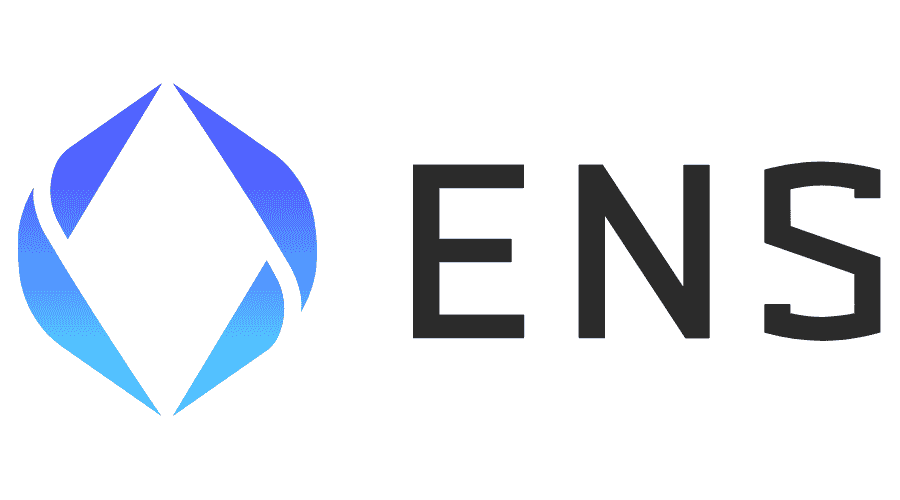As the cryptocurrency space is highly technical, it can be overwhelming for first-time users and non-tech-savvy individuals to onboard.
Take crypto transactions, for example. To send a crypto payment, you need a long public wallet address composed of a string of digits and letters of the alphabet that looks like gibberish. Moreover, users have a different public address for every cryptocurrency, making it difficult to manage and confusing for crypto beginners.
ENS, short for Ethereum Name Service, aims to make the crypto and decentralized finance space a bit simpler by allowing a user to create a universal nickname for all your public addresses and decentralized websites. Instead of having an unreadable string of keys for each crypto address, you’ll have a single ENS domain, like “Rick.eth,” where you can receive any kind of crypto and NFTs.
ENS aims to become the naming protocol of the decentralized internet by creating portable Web 3.0 usernames that are interoperable across all blockchains and decentralized apps (dApps). To understand its impact, let’s take a look at how ENS works.
This Forkast.News explainer will explore:
- What is ENS?
- How does ENS work?
- What is the ENS token?
- Why does ENS stand out?
- What does ENS mean for the crypto industry?
What is ENS?
In a nutshell, ENS is a name and lookup service built on the Ethereum blockchain that allows crypto users to translate their machine-readable addresses to human-readable addresses. Think of it as a nickname generator for public Ethereum addresses, aiming to make crypto more accessible.
Say your friend wants to pay you back for dinner in cryptocurrency. To do so, you must share your Ethereum public address made up of 42 hexadecimal characters, which might look like “0xDC25EF3F5B8A186998338A2ADA83795FBA2D695E.” This is the equivalent of your IBAN, enabling others to send crypto to your wallet. With ENS, you can create a “nickname” for your public address, so instead of sharing that complicated string of characters with your friend, you’ll have a link, like “Rick.eth” — which is automatically connected to your public address.
Besides Ethereum addresses, ENS also offers human-readable domains for other crypto wallets, websites, content hashes and metadata — aiming to be your Web3 username, connecting all your addresses and websites under a single nickname, so that you can receive any type of cryptocurrency or NFTs via your ENS domain.
As per the ENS Documentation, the protocol calls itself “a distributed, open, and extensible naming system” that offers decentralized, blockchain-secured domain naming and look-up services. Due to its decentralized nature, ENS isn’t controlled by a single entity. This makes ENS more secure than centralized naming services as there is no single point of failure.
How does ENS work?
ENS is built on two Ethereum smart contracts. The first smart contract is the ENS registry, which records all the domains registered on ENS and stores three critical pieces of information about each domain: the owner of the domain, the resolver for the domain, and the caching time for all records under the domain. The second smart contract is the resolver, which translates the domain names to the machine-readable addresses and vice versa. This second smart contract matches each domain to the corresponding user, website or address.
Those wishing to create their Web3 username can visit the ENS app and start by searching for an available domain name. Once you find one, you’ll simply have to follow the registration process, which includes confirming two transactions from your wallet and paying the yearly fee, which is US$5/year for names longer than five characters. Once you own the domain, you can link it to your crypto wallets, websites, and create multiple subdomains, like email.rick.eth or website.rick.eth — all connected under the same ENS domain.
As ENS domains are limited, crypto natives are rushing to secure their nicknames, much like in the early days of DNS names. Some are even dabbling with ENS domain flipping, which can be a lucrative side hustle, considering that exchange.eth was sold for 6,660 ETH, or US$609,000, while weather.eth was sold for 300 ETH, or US$27,000, at the time of the auction.
ENS doesn’t just support .eth, but also the most popular DNS names including .com, .org, .io, .app, and more.
What is the ENS token
As ENS is an open-source, fully decentralized protocol, it is not managed by a traditional company hierarchy. ENS is community-governed as a DAO (decentralized autonomous organization), which leads us to the ENS token.
The ENS DAO is governed by the ENS token — the protocol’s utility and governance token used to submit proposals and cast votes to influence the protocol’s future development. Anyone holding ENS can cast their votes for proposals on the ENS DAO.
ENS is an ERC-20 token, trading at US$51.08, as the 110th largest cryptocurrency, with a market capitalization of US$1.1 billion, at press time. The token has a maximum supply of 100 million coins and a circulating supply of 19.6 million. Of the total ENS supply, 25% was airdropped to ETH holders, 25% went to ENS contributors, and the remaining 50% was allocated to the ENS DAO.
Why does ENS stand out?
Ethereum Name Service is essentially the Web 3.0 version of DNS, short for Domain Name Service. ENS offers a decentralized alternative to the internet’s traditional DNS, removing the risks associated with its single point of failure.
As a blockchain-based protocol, ENS is inherently more secure and censorship-resistant due to being built on Ethereum. The fact that ENS is essentially two smart contracts enables peak interoperability with other smart contracts and the entire Ethereum ecosystem.
ENS is the first service of its kind for crypto and blockchain addresses. There are other services that are trying to replace the old DNS for the internet, but ENS is currently the only player in its league that offers human-readable nicknames that can work across all your wallets, dApps and decentralized websites. By transforming complicated strings of characters into short and memorable, human-readable links. ENS also serves to make crypto transactions more understandable and accessible for blockchain beginners. Similar services may appear in the future, but as of yet, ENS does not have any comparable rivals that can do all that it does.
What does ENS mean for the crypto space?
ENS brands itself as “an open public utility that belongs to the community” and with its decentralized components and community governance, it may grow into a significant backbone of the crypto and Web 3.0 ecosystem.
The cryptocurrency space is a highly technical field, which is often enough to discourage crypto beginners from exploring this space. Yet, ENS solves this major adoption hurdle, by making crypto more accessible and easier to use. ENS translates the long series of numbers that are machine-readable public addresses to short, memorable links, that users can use to transact, interact with dApps, and receive any type of cryptocurrency and NFTs. More so, it aims to connect all wallets, websites, and subdomains of a person under a single link, making the crypto space more user-friendly and less technical. ENS and similar incentives will be crucial for removing the psychological roadblocks of global crypto adoption.
The ENS DAO has also attracted significant interest to the protocol, as it airdropped 25% of the total token supply with the launch of the DAO on November 9, 2021. The ENS token quickly gained traction among investors, as its market capitalization soared past the US$1 billion mark on November 10 — only a day after the launch of the ENS DAO.
While the ENS roadmap only goes as far as 2021, ENS plans to integrate the full DNS namespace, meaning that owners of any internet domains will be able to claim them on ENS. This will position ENS as a parallel extension of DNS, creating cross-platform Web 3.0 usernames that will become a core component of our decentralized identity. Because it makes the blockchain and crypto world so much more accessible to beginners, it is becoming a fundamental component of the future crypto space.





